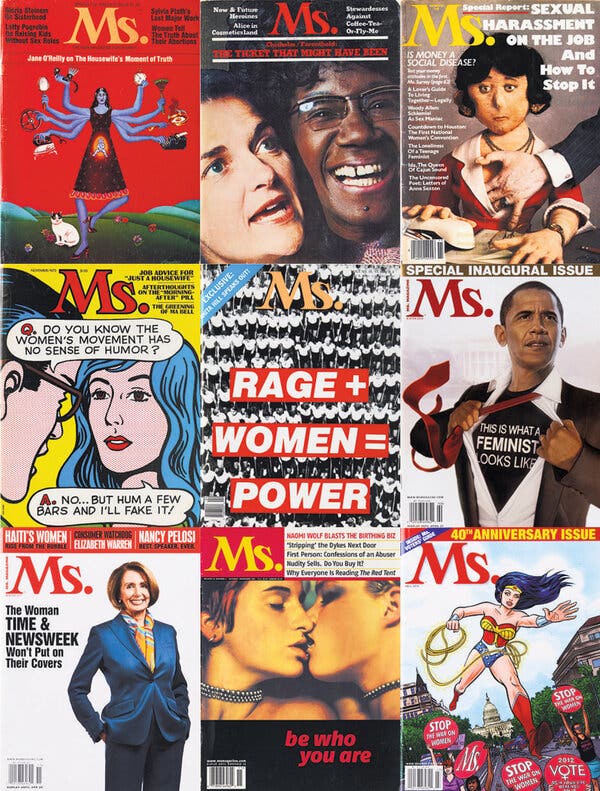50 YEARS OF MS.: The Best of the Pathfinding Magazine That Ignited a Revolution, edited by Katherine Spillar and the editors of Ms.
I had my first conscious interaction with Ms. magazine as a small child when I read — or rather, had read to me — a story-poem called “Black Is Brown Is Tan.”
Part of the magazine’s delightful kids’ section, “Black Is Brown Is Tan” is about a mixed-race family not unlike my own who go about their daily routines like any other Americans. Though I was young, I remember the illustrations, by Emily Arnold McCully, with acute clarity: the rosy cheeks of the white dad, the short Afro and hoop earrings of the Black mom, and, perhaps most important, the sense of safety and warmth that permeated every page. In our house, where my mother was careful about the messaging of the media and toys we consumed, the “Stories for Free Children” section was always welcome. As for the magazine they appeared in? Well, it was canon.
Of course, what older readers probably remember are the magazine’s bread and butter, all those unapologetically feminist features and sidebars that combined the political with the personal and boasted bylines like Audre Lorde, Barbara Ehrenreich, Susan Brownmiller and Eleanor Holmes Norton. Containing stories on everything from the question of equal pay to the politics of body hair, “50 Years of Ms.” provides a snapshot of the issues facing many American women from the 1970s on, including the concerns and contributions of Black women to the 20th-century feminist and political project.
It began as an insert in New York magazine, featuring a famous cover story titled “Click! The Housewife’s Moment of Truth,” about ah-ha! moments centering on sexism and misogyny. First a monthly, later a quarterly, Ms. was famously co-founded by the writer and activist Gloria Steinem, who contributes a foreword. The question, of course, is how all this reads in 2023.
Ms. was often prescient, anticipating and exploring topics that feel just as relevant today as they did at the time of writing, including misinformation about menopause (1993), the harmful effects of pornography (2004) and the controversies and tensions surrounding the evolution of personal pronouns (1985). Under the headline “The Search for Signs of Intelligent Life in the Twenty-First Century” in 1990, a wry Jane Wagner predicts that the feminist movement “for the umpteenth time will be pronounced dead,” the only three types of remaining government will be “neo-fascism, regular fascism and fascism lite” and that the “flesh-colored Band-Aid will come in many colors.”

As for what Ms. didn’t get quite so right? That’s harder to determine — understandably, “50 Years of Ms.” has been edited and curated so that the magazine is painted in the best possible light. As such, any of its missteps appear few and far between, though that was hardly the case in reality. In 1986, after the publication of a cover showing two pregnant white women, the author Alice Walker resigned from the masthead, citing the magazine’s lack of diversity.
Which brings me to my biggest criticism: Elements of this compendium feel weirdly rooted in the past. Perhaps that’s unfair, considering what the book primarily is — a ceommemoration of a legacy. But I was surprised and disappointed that the blurbs on the back cover didn’t include any from women (or men) under the age of 60.
Shockingly, the introduction, by the editor Katherine Spillar and the publisher Eleanor Smeal, makes little mention of the lively, powerful, diverse and transformative contemporary online discourse around gender politics and what it has inspired among younger generations of women. There is no mention of the influence of any other website or blog. Next to nothing about #MeToo. And though all these owe an obvious and enormous debt to Ms., the reader gets the feeling that maybe Spillar and Smeal don’t think the current iteration of the magazine owes much to them. And that’s a shame.
Still, the book contributes a lot more to the conversation than it ignores. For one thing, there are the pictures. Reprints of the magazine’s art chart the publication’s evolution, from stories about feminists’ supposed lack of humor to the 2022 repeal of Roe v. Wade. On Page 59, a tasteful female nude accompanies a provocative 1974 story about masturbation by the sex educator Betty Dodson. From 1973: impactful, celebratory, close-up photographs of Congresswoman Shirley Chisholm and Frances “Sissy” Farenthold, who, a year prior, had sought the Democratic nominations for president and vice president. Closer to the book’s end are the three covers featuring Nancy Pelosi.
The recurring reader letters are fascinating and often powerful. Women write in to comment on the sexual harassment of Anita Hill, or to bear witness to and embrace their identities as survivors of domestic or sexual violence. One letter, published in the September 1978 issue, details how its correspondent, upon arriving at a county clerk’s office to get married, was handed a “New Homemaker’s Kit” that included bottles of Fantastik and Bufferin, pantyhose and a can of Spray ’n Wash.
Last month, I took “50 Years of Ms.” to my hometown to show my mother. My mom is currently in an assisted living facility and suffering from dementia. Her short-term memory is all but gone, and her long-term memories are on their way out. (This year, for the first time, she forgot my birthday.)
But Ms. is not something my mother — the first feminist I ever knew and the inspiration for much of the work I’ve done as an adult — has yet forgotten. As I sat next to her recliner in the small apartment where she now lives, we looked at the book and she reminisced about stories she remembered and covers she loved.
It occurred to me, then, that it doesn’t feel like a coincidence that as Ms. turns 50, so do I. It also doesn’t feel like a coincidence — and don’t hate me for saying this — that this was the year of “Barbie.” My mother refused to let me play with Barbies. I certainly can’t imagine that the editors of Ms. ever imagined that there would someday exist a subversive, feminist salute to the much-maligned doll that would involve close to a dozen mentions of the word “patriarchy,” not to mention the sign-off of the manufacturer. But at its best, American media has a way of taking a country by surprise, of meeting a moment of political and personal potential and changing the way we see our culture.
Click!
Anna Holmes is a writer living in Los Angeles. She is working on her third book.
50 YEARS OF MS.: The Best of the Pathfinding Magazine That Ignited a Revolution | Edited by Katherine Spillar and the editors of Ms. | Illustrated | 516 pp. | Alfred A. Knopf | $50




